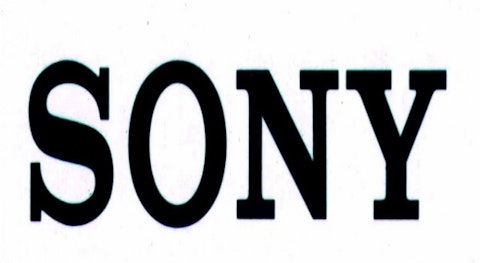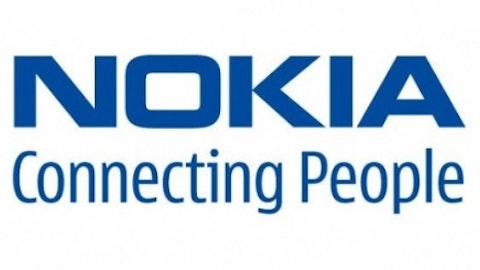Sony Corporation (ADR) (NYSE:SNE) and Nintendo aren’t afraid of mobile gaming. But the facts are that mobile game revenue surpassed portable console games at the end of last year and user engagement on smartphones and tablets continues to rise. Both companies could take a lesson from Nokia Corporation (ADR) (NYSE:NOK), the one-time champion of mobile phones, which didn’t see iOS or Android as threats either. We all know how that worked out.
Two different markets
Both Nintendo and Sony Corporation (ADR) (NYSE:SNE) made appearances at E3, an annual video game conference where Sony unveiled some new information about the upcoming PlayStation 4. In an interview with AllThingsD Sony Corporation (ADR) (NYSE:SNE) President Jack Tretton was very confident about the future of console gaming. “Turn to anyone … here in this crowd,” he said, “and ask them if they’re turning to smartphones or tablets over consoles. And then run.”
Of course very few of the attendees of a video game conference are going to tell you mobile gaming is better than console gaming. These are the “hardcore gamers,” the people that want the next great thing in gaming.
The comparison of smartphones and tablet to set-top game consoles is something like apples to prime rib. I’m a vegetarian, but I can tell you prime rib tastes better.
A real comparison
Portable consoles ought to be what these games are measured against first. In this case, the market has all but declared mobile apps the winner. Even with prices of $40 to $50 for Nintendo 3DS and PS Vita games, game app revenue is vastly exceeding both platforms combined.
Between the fourth quarter of 2012 and the first quarter of this year, iOS game revenue increased 40% while Google Play’s game revenue increased 100%. Growth like this must come at the expense of other entertainment, and indeed portable console sales fell dramatically from their seasonally high fourth quarter.
Gamers only have so much money to spend, and they’ve chosen to spend it mostly on in-app purchases. The days of spending $50 on a portable game are numbered. Nintendo and Sony Corporation (ADR) (NYSE:SNE) ought to figure out how they can replicate the model instead of ignoring the problem it’s creating.
Nintendo’s stubbornness
This trend is of much greater importance to Nintendo than Sony Corporation (ADR) (NYSE:SNE) because its Wii U console, released last fall, has sold poorly. Currently, the company is largely dependent on its portable platform to continue selling games. As spending on mobile game apps rises and portable console spending falls, however, the company finds itself in a tough situation that CEO Satoru Iwata is refusing to recognize.
Instead of cutting the price on the Wii U, which the company points out is already aggressively priced, Nintendo is hoping a slate of new proprietary titles will help boost sales. These releases are timed to go head-to-head with stiff competition from Sony and Microsoft Corporation (NASDAQ:MSFT) as they release their new consoles with their own flagship game titles. Nintendo may be setting itself up for more disappointment.
Iwata reiterated the company’s resistance to mobile apps, stating “Our IP is the most important asset with which we can attract people to our own platform” in an interview with AllThingsD. Meanwhile, Sony and Microsoft Corporation (NASDAQ:MSFT) have introduced apps that act as companions to their games and consoles.
At home
I know I said the comparison between set-top consoles and mobile platforms isn’t quite appropriate, but that doesn’t mean mobile platforms won’t have an impact on console game sales. Americans are using their phones and tablets for entertainment during prime gaming hours, and more frequently using them to play games.
70% of the American adult population uses a tablet at some point between 7:00 p.m. and 9:00 p.m. – prime gaming hours. There are a finite number of hours during the day for gaming and entertainment, and while enthusiasts aren’t turning to their tablets or smartphones for their gaming fix, many more casual gamers are.
This is another misfortune for Nintendo in particular, which found great success with the casual gaming market and its Wii console. But it also likely means fewer game sales for all consoles as more consumers turn to their smartphones and tablets for entertainment options. Even if gamers still buy graphic intensive games, less “serious” titles may see poor sales as big name game makers such as EA have started producing mobile game apps.
A shrinking market
Sony and Nintendo refuse to see tablets and smartphones as real competition for eyeballs. Sony’s gamer-first approach to this next generation of consoles will likely attract the most console gamers, but that crowd is shrinking – in all likelihood due to the introduction of smartphones and tablets.
The last E3 conference with new console announcements was in 2005. E3 drew a record 70,000 attendees. In 2001, with the announcement of the Xbox and Gamecube, 62,000 people attended the conference. This year, just 48,000 showed up. A lot of gamers seem to have lost their enthusiasm, myself included. (But I’m sure those that haven’t will let me hear it in the comments section). Sure, there are some details that may have led to lower attendance, but the level of enthusiasm around new consoles is not quite what it used to be.
There’s also the recent trend in video game sales, but that’s not without its flaws. Console and game sales usually decline significantly before a new console cycle. Yet, this time around, the decline appears much more pronounced. Total sales are still above where they were in 2006 at the beginning of the last console cycle, but the fall from its high in 2008 has been much more precipitous compared to the lull from 2003 to 2005.
So even if Sony captures the majority of the market, as DFC analyst Jeremy Miller expects, the market appears to be in decline.
This is why Microsoft Corporation (NASDAQ:MSFT) has shifted the focus of the Xbox from a gaming console to an entertainment system. It successfully transformed the previous generation Xbox 360 from a Halo machine to a centerpiece in more than 70 million living rooms with its motion and voice sensor Kinect and a marketing shift. As a result, Microsoft started selling more consoles in the second half of the products life-cycle. In 2012, the company’s Xbox division increased revenue by 60%.
The real coup by Microsoft Corporation (NASDAQ:MSFT) is expanding its Xbox Live platform, which for a subscription fee allows users to access Internet services through their device. Xbox Live will play a crucial role in the upcoming Xbox One, which relies heavily on the cloud. This means Microsoft Corporation (NASDAQ:MSFT) is less reliant on game sales, as it has a subscription revenue stream in Xbox Live. So even if console game sales don’t reach the peaks they did in 2008, Microsoft is better positioned than Sony or Nintendo.
Mobile monster
For now, Sony and Nintendo are choosing to ignore iOS and Android at their own risk. Nintendo has the most at risk with its stakes in casual and portable gaming and a floundering set-top console. It’s not even close to the diversification of Sony. If the company continues to struggle, it may go the way of Sega.
Sony is going after the market of hardcore gamers that appears to be diminishing. Meanwhile, Microsoft is expanding its console into an all-in-one entertainment solution. Tablets and smartphones are at least part to blame for the rapid decline in video game sales. I believe they will continue to hold back the next generation of consoles as well.
The article Little Games, Big Impact originally appeared on Fool.com and is written by Adam Levy.
Adam Levy has no position in any stocks mentioned. The Motley Fool recommends Nintendo. Adam is a member of The Motley Fool Blog Network — entries represent the personal opinion of the blogger and are not formally edited.
Copyright © 1995 – 2013 The Motley Fool, LLC. All rights reserved. The Motley Fool has a disclosure policy.




